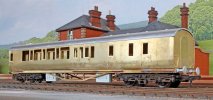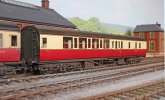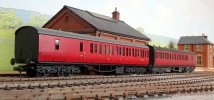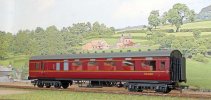You are using an out of date browser. It may not display this or other websites correctly.
You should upgrade or use an alternative browser.
You should upgrade or use an alternative browser.
4mm Llanfair ....
- Thread starter LarryG
- Start date
LarryG
Western Thunderer
You're right about the boarded crossing. There will in fact be a railwaymen's walkway from the crossing to the platform. I am just working with as broad brush at the moment to get major buildings positioned. The initial hands-on task will be the lay a new turnout and siding to the goods shed and alter the adjoining headshunt slightly which will henceforth hold fewer coaches.
paulc
Western Thunderer
Hi Larry , I've been MIA so have come upon this late . The signal box looks best in the last position . Ref the length of the platform, how many times have you seen a photo of a train that's dwarfed by the platform length . It seems that the designers of stations were always optimistic on customer numbers .
Cheers Paul
Cheers Paul
LarryG
Western Thunderer
A BR carmine & cream LMS diagram D1968 brake third has been added to the "from another region" fleet. A few weeks ago this coach was BR maroon...
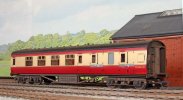
I've gone in for higher slate panels. The corridor connections need more weathering...
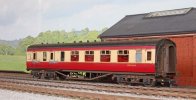
As I have oft' mentioned, these brakes had deeper sides that were welded to the chassis. They overlapped the welded solebars. Welded bogies too...
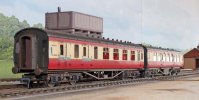

I've gone in for higher slate panels. The corridor connections need more weathering...

As I have oft' mentioned, these brakes had deeper sides that were welded to the chassis. They overlapped the welded solebars. Welded bogies too...

LarryG
Western Thunderer
This is the post-war version corridor third with additional doors in the corridor. Tension-lock couplings might only be temporary. It is something I will give more thought to in the future...
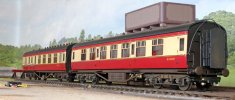
Welded underframes. Due to acute shortage of materials because road vehicles had priority, some coaches used up parts salvaged from war-damaged coaches. Therefore, window vents, corridor connections and bogies varied.
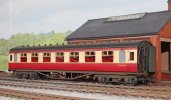
It will be seen that the metal hoods or louvres over the droplights are missing on the model of the corridor third. Metal hoods on metal panels were a source of corrosion and so were often removed and the holes plates over. Most earlier coaches had wood panels and wooden louvres and these were never removed, so one can assume corrosion in this area was not a problem on Period 1 and wood panelled Period II coaches.

Welded underframes. Due to acute shortage of materials because road vehicles had priority, some coaches used up parts salvaged from war-damaged coaches. Therefore, window vents, corridor connections and bogies varied.

It will be seen that the metal hoods or louvres over the droplights are missing on the model of the corridor third. Metal hoods on metal panels were a source of corrosion and so were often removed and the holes plates over. Most earlier coaches had wood panels and wooden louvres and these were never removed, so one can assume corrosion in this area was not a problem on Period 1 and wood panelled Period II coaches.
Last edited:
LarryG
Western Thunderer
The LMS D1915 is also in carmine & cream livery now. Being 7½ bay excursion stock, these coaches were not fitted with destination board brackets in the cantrail. This model has my own bogie castings because they were there ready-built off a scrapped coach. I still prefer the ones I've been buying in recently...
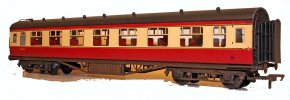
The running number is at the LH end. They were applied to the RH end from around 1952 and given a regional suffix letter...
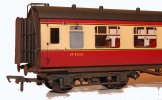
Only one more coach remains in BR maroon, but I am in two minds about this one. It could carry LMS lining and still be correct if it was painted in early 1949 before blood & custard was adopted as the standard BR livery.

The running number is at the LH end. They were applied to the RH end from around 1952 and given a regional suffix letter...

Only one more coach remains in BR maroon, but I am in two minds about this one. It could carry LMS lining and still be correct if it was painted in early 1949 before blood & custard was adopted as the standard BR livery.
Last edited:
LarryG
Western Thunderer
A touch of LNWR in GW territory. Diagram D306 corridor brake third. Initial batches were built by the LNWR and identical batched were rebuilt from WW1 Ambulance coaches during LMS days to D1712. This coach retains the original LNWR axlebox covers...
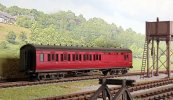
Having rode in one to Delph, I can tell you those toplight windows made the corridor very light and airy. Most, it seems, carried either varnished LMS maroon or BR carmine red, so BR mustn't have had much regard for them. They were quite prolific until 1954, but had gone by 1956...
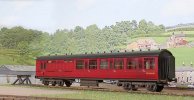

Having rode in one to Delph, I can tell you those toplight windows made the corridor very light and airy. Most, it seems, carried either varnished LMS maroon or BR carmine red, so BR mustn't have had much regard for them. They were quite prolific until 1954, but had gone by 1956...

Last edited:
LarryG
Western Thunderer
I got around to painting on of my two Dapol Large Prairie Tanks from BR lined green to plain black. For body removal, it was a case of remove smokebox door and unplug DCC adaptor, three screws out and hey presto. Then the cab roof and tool boxes were unclipped. My attempts to remove the lining were aborted becasue of rivet detail.
The body was given a light waft over of Halfords Plastic Red Oxide as a protective shield followed by Halfords Satin black that had been decamped into the spraygun. My weathering 'rust' colour followed using my small spraygun and finally weathering powder. Engraved number plates are on order...
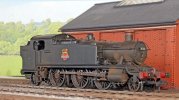
I spent over an hour trying to reassemble the loco, the difficult part being locating the DCC plug inside the smokebox and then plugging in the DC plate through the smokebox front. Then the body would not sit down on the chassis! In fairness, Dapol do state that body removal is not recommended. Rather than go through this again with the green Prairie, it was easier to move the period of my layout to 1956...
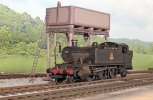
The body was given a light waft over of Halfords Plastic Red Oxide as a protective shield followed by Halfords Satin black that had been decamped into the spraygun. My weathering 'rust' colour followed using my small spraygun and finally weathering powder. Engraved number plates are on order...

I spent over an hour trying to reassemble the loco, the difficult part being locating the DCC plug inside the smokebox and then plugging in the DC plate through the smokebox front. Then the body would not sit down on the chassis! In fairness, Dapol do state that body removal is not recommended. Rather than go through this again with the green Prairie, it was easier to move the period of my layout to 1956...

Mike Garwood
Western Thunderer
Larry
Loving the weathering, it's really in fitting with the rest of the stock.
Mike
Loving the weathering, it's really in fitting with the rest of the stock.
Mike
LarryG
Western Thunderer
I was spraying some coaches and so it seemed an opportune time to spray-weather the underframes of the Dapol 43xx 2-6-0. Before that though, the wheel rims were painted matt black. The bufferbeams were also toned down a bit. For the moment it is "recently ex works"...
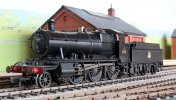
I forgot to mention that no way was I going to dismantle another Dapol loco. The small spraygun I use is basically an airbrush with a spraygun type trigger. It's fine spray and narrow 'fan' enabled me to paint the wheels without affecting the bodywork and so no masking was required...
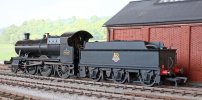

I forgot to mention that no way was I going to dismantle another Dapol loco. The small spraygun I use is basically an airbrush with a spraygun type trigger. It's fine spray and narrow 'fan' enabled me to paint the wheels without affecting the bodywork and so no masking was required...

Last edited:
LarryG
Western Thunderer
I mixed from black red and yellow (cellulose) a sort of rusty rail colour. It is this colour that is thrown up from the rails onto passing trains. I spray it only rolling stock chassis and parts of the bodies. Also loco chassis and all over loco bodies if I want them to look well used in traffic. Additional rust is by using Humbrol weathering powder (Dark Earth 16421). Hope this is of assistance Khris.Larry<
could I trouble you to describe the colours used and the way you did the rods please?
They look great!
Khris
michael mott
Western Thunderer
Larry that is interesting about your spray gun Can you say what type it is? You have definitely mastered its use as the results are fantastic.
Michael
Michael
LarryG
Western Thunderer
Sparmax spraygun with top cup (large). Avoid the one with side cup. It is only really useful for detailing. A larger gun is used for general spraying...Larry that is interesting about your spray gun Can you say what type it is? You have definitely mastered its use as the results are fantastic.
Michael
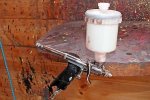
Portable compressor...
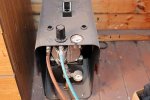
michael mott
Western Thunderer
Thanks Larry I shall look them up.
Michael
Michael
Thank you Larry.I mixed from black red and yellow (cellulose) a sort of rusty rail colour. It is this colour that is thrown up from the rails onto passing trains. I spray it only rolling stock chassis and parts of the bodies. Also loco chassis and all over loco bodies if I want them to look well used in traffic. Additional rust is by using Humbrol weathering powder (Dark Earth 16421). Hope this is of assistance Khris.
Appreciated
Khris

